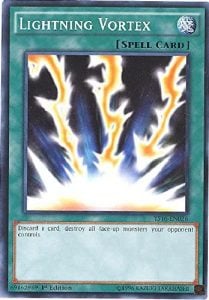Yu-Gi-Oh is a card game targeted toward children. However, unlike most TCG, the nitty-gritty mechanics are pretty complicated. This article will look at the many rulings of Yu-Gi-Oh that beginning players likely made when playing Yu-Gi-Oh TCG. You can view Part 1 here.
Archetype Monster and just monster (e.g. Jinzo and Dark Magician)
 SCENARIO: You're dueling against an opponent who says he only wants to play old school. For some reason, he was using 'Jinzo - Lord'. Suddenly, he equips "Amplifier" to Jinzo - Lord. You said he couldn't do that because 'Jinzo - Lord' is not 'Jinzo'. The opponent said, "It is Jinzo! Jinzo - Lord!". You said, "no, it has to be just Jinzo. Otherwise, the spell card would say "Jinzo" monster". Your opponent is still confused.
SCENARIO: You're dueling against an opponent who says he only wants to play old school. For some reason, he was using 'Jinzo - Lord'. Suddenly, he equips "Amplifier" to Jinzo - Lord. You said he couldn't do that because 'Jinzo - Lord' is not 'Jinzo'. The opponent said, "It is Jinzo! Jinzo - Lord!". You said, "no, it has to be just Jinzo. Otherwise, the spell card would say "Jinzo" monster". Your opponent is still confused.
Yu-Gi-Oh! is a complex card game with numerous archetypes. What makes an archetype an archetype is a fact that it has support. Supports are cards that help the archetype in several ways, and it usually references the archetype's name in its text. For example, Infernity Launcher is a support card for the Infernity archetype as its text references the archetype (" You can send this card to the Graveyard, then target up to 2 "Infernity" monsters in your Graveyard; Special Summon them").
Some archetypes (especially the older ones) have support cards that only support one monster in the archetype. For example, Edge Imp Chain is a monster that can only add "Edge Imp Chain" if it attacks. That's easy to understand. However, the confusion starts with archetypes like Dark Magician, Jinzo, Harpie Lady, etc. Let's have a look at the Dark Magician archetype.
These two spells are support cards for Dark Magician.
- The Eye of Timaeus - "Target 1 "Dark Magician" monster you control; Fusion Summon 1 Fusion Monster from your Extra Deck..."
- Dark Magic Curtain - "Pay half your LP; Special Summon 1 "Dark Magician" from your Deck."
For Eye of Timaeus, it specifies that I can use any "Dark Magician" monster to Fusion Summon a monster from the Extra Deck. Therefore, I can send monsters like "Dark Magician Girl", "Dark Magician of Black Chaos", "Skilled Dark Magician" to the grave to perform the Fusion Summon since all of them have "Dark Magician" in their name. The next card, Dark Magic Curtain, can ONLY Summon Dark Magician specifically says "Dark Magician" and NOT "Dark Magician" monster. To further complicate this, let's look at the spell card, "Dark Magical Circle".
- Dark Magical Circle - "When this card is activated: Look at the top 3 cards of your Deck, then you can reveal 1 "Dark Magician" or 1 Spell/Trap that specifically lists the card "Dark Magician" in its text"
This spell card can add any trap/spell that specifically list "Dark Magician" in its text (e.g. Dark Magic Curtain, Bond Between Teacher and Student, etc). However, it cannot add cards like The Eye of Timaeus because The Eye of Timaeus doesn't actually list "Dark Magician". It instead lists '"Dark Magician" monsters'.
We then have another scenario like Elegant Egotist, which makes this whole thing even more confusing. Elegant Egotist is a spell card that enables the player to Special Summon another "Harpie Lady" from the Deck. However, the players can also Special Summon the monster, "Harpie Lady 1", "Harpie Lady 2", "Harpie Lady 3" and "Cyber Harpie Lady", with Elegant Egotist. Why does Elegant Egotist allow the player to Special Summon the other Harpie Lady monsters when the spell card specifically lists "Harpie Lady?" The reason is that all four of those cards have this effect.
- "(This card's name is always treated as "Harpie Lady".)"
Therefore, despite not having the same name physically on the card, it is technically treated as the same card no matter what, leading to its own issues (see Maximum of Three Rule).
Maximun of 3 Rule
SCE NARIO: You're playing on Dueling Book, and the opponent has 3 Cyber Harpie Lady on the Field. The opponent then activates Elegant Egotist. Rather than summoning Harpie Lady Sisters, he summons Harpie Lady 2 from the Deck. You told him that's not possible, and he's automatically disqualified due to having more than three copies of "Harpie Lady" in his Deck. He responded by calling you a cheater and an idiot, then quitting the game.
NARIO: You're playing on Dueling Book, and the opponent has 3 Cyber Harpie Lady on the Field. The opponent then activates Elegant Egotist. Rather than summoning Harpie Lady Sisters, he summons Harpie Lady 2 from the Deck. You told him that's not possible, and he's automatically disqualified due to having more than three copies of "Harpie Lady" in his Deck. He responded by calling you a cheater and an idiot, then quitting the game.
The Maximum of 3 Rule is a rule where you can only have at most three copies of the one card of the same name in your Deck, Side Deck and Extra Deck. For example, I can only have three Ash Blossom in my Deck, but not four or higher. This rule helps prevents hyper consistency. However, the confusing part is how the rules interact with cards that have an effect treated as the same as another card. Basically, if a card has an effect that is treated as another card's name, then it is counted as that in the Deck as well (e.g. Cyber Harpie Lady and Harpie Lady 1 are treated as Harpie Lady. Therefore, you can only have a total of three of these cards in your Deck).
For a long time, this rule has hurt the Harpie Lady Archetype. Before Harpie Queen, all Harpie Lady (Harpie Lady, Harpie Lady 1, Harpie Lady 2, Harpie Lady 3 and Cyber Harpie Lady) are treated as Harpie Lady. A player can never build a pure Harpie Lady Deck because they can only have three copies of Harpie Lady despite Konami making five different monsters. Why did Konami do that? It's because of Elegant Egotist. A spell that only works if "Harpie Lady" (Not a Harpie monster) is on the field. Thankfully, this stopped after the release of Harpie Queen, where she is only treated as a Harpie Lady while she's on the field and in the Graveyard. However, it can't be Special Summoned by Elegant Egotist.
Some other cards follow this same ruling. For example, the Legendary Ocean and Umi.
Disconnected Archetype
SCE NARIO: You have Magical Android and Krebon on the field while your opponent controls a face-up Gravity Bind, Wave Motion Cannon and Prohibition. Your opponent is one turn from inflicting 8000 damage with Wave Motion Cannon. You then tribute Magical Android and Decoyroid to Tribute Summon Armoroid, triggering its effect to banish all his face-up Spell/Trap. Your opponent screams bloody mary, saying that you can't do that as you didn't tribute any roid monster. You then told them that Magical Android is a roid monster. Your opponent then calls you an idiot, and say that the card only works for monsters that Syrus from the GX anime used.
NARIO: You have Magical Android and Krebon on the field while your opponent controls a face-up Gravity Bind, Wave Motion Cannon and Prohibition. Your opponent is one turn from inflicting 8000 damage with Wave Motion Cannon. You then tribute Magical Android and Decoyroid to Tribute Summon Armoroid, triggering its effect to banish all his face-up Spell/Trap. Your opponent screams bloody mary, saying that you can't do that as you didn't tribute any roid monster. You then told them that Magical Android is a roid monster. Your opponent then calls you an idiot, and say that the card only works for monsters that Syrus from the GX anime used.
Archetypes are a family of cards that have supports that support one another. An archetype usually has a common name in its name to specify what archetype it belongs to. For example, Fluffal Owl and Fluffal Sheep are part of the Fluffal family. It is also possible for some cards to be a part of two different archetypes. For example, Infernity Archfiend is part of the Infernity and Archfield archetype. However, the confusion comes when there are cards that don't make it evident that it's part of an archetype.
For the roid archetype, any monsters with roid in their name are part of the roid archetype. This includes monsters like "Elemental HERO Necroid Shaman", "Dark Jeroid", "Magical Android", and "Salamangreat Zebroid X". This seems to be an oversight from Konami as many later supports explicitly state that it only helps Machine "roid" monsters.
Things then become more complicated with cards like Summoned Skull. Despite not having Archfiend in its name, Summoned Skull is part of the Archfiend archetype. The reason for this is because, in its card lore, it has this text despite being a normal monster:
- "(This card is always treated as an "Archfiend" card.)"
The reason for this is because of translation issues. In the OCG, Summoned Skull was called "Demon Summoning" (or Archfiend’s Summoning).
Cost VS Effect
SCE NARIO: Your opponent activates Lightning Vortex to discard "Broww, Huntsman of Dark World" to destroy all your face-up monsters. He then proceeds to draw a card from Broww's effect. You told him that he couldn't do that as Broww wasn't discarded by a card effect. The opponent then yells at you and says Lightning Vortex discarded Broww. You told him that it's a cost, not an effect.
NARIO: Your opponent activates Lightning Vortex to discard "Broww, Huntsman of Dark World" to destroy all your face-up monsters. He then proceeds to draw a card from Broww's effect. You told him that he couldn't do that as Broww wasn't discarded by a card effect. The opponent then yells at you and says Lightning Vortex discarded Broww. You told him that it's a cost, not an effect.
Most cards usually come with a condition, cost and effects. A cost is something you have to pay before activating the effect of a card. For example, cards like Lightning Vortex has a clear cost (discarding a card) and effect (destroying the field). Rescue Rabbit also has a cost and an effect. For example, banishing itself is the cost, and Special Summoning two monsters is the effect. Not all costs are bad. In fact, some costs are better than the actual card effects. Let's look at Cherubini, Ebon Angel of the Burning Abyss. Cherubini's cost involves dumping a level three monster from the Deck to the Graveyard, while the actual effect is just powering up a monster on the field. Arguably, the cost is a lot better than the actual effect. But how do we know what is the cost and what is the effect? The key is the semicolon. Whatever comes before the semicolon is the cost, while the thing that comes after is the effect. Let's look at the cost and effect of the following cards:
- Elemental HERO Thunder Giant: Once per turn (condition): You can discard 1 card, then target 1 monster on the field with original ATK less than the ATK of this card (cost); destroy that target (effect).
- A Hero Lives: If you control no face-up monsters (condition): Pay half your LP (cost); Special Summon 1 Level 4 or lower "Elemental HERO" monster from your Deck (effect).
Pretty simple, right? Just keep in mind that not all cards come with a cost. Some cards don't have a cost (e.g. Pot of Greed).
Now here's where the confusion comes in. If a card gets negated, you still have to pay the cost. That's because the cost is something you have to do before activating the effect anyway. For example, if I activate Solemn Judgment and pay 4000 life points, and my opponent negates it with "Counter Counter", I don't get to regain my life points. Similarly, if my opponent discards a card to activate Lightning Vortex, and then I negated Lightning Vortex, they don't get to add back the card they discarded because it was a cost. In saying that, cards with better costs than the effects can abuse this. For example, Cherubini, Ebon Angel of the Burning Abyss has a far better cost than the actual effects. Therefore, I don't need to worry about its effect getting negated because no matter what, I'll be sending a Burning Abyss monster from my Deck to the grave since that part is a cost.
The next confusion comes with cards that interact with card effects (e.g. Dark World). All Dark World monsters have their effects activated when a card effect discards them. Notice how it specifies card effects? Therefore, any cards that discard as a cost don't work with Dark World. Let's have a look at two examples of cards that work and don't work with Dark World.
- Lightning Vortex: "Discard 1 card; destroy all face-up monsters your opponent controls." (Discarding is a cost. It doesn't work with Dark World)
- The Gates of Dark World: "You can banish 1 Fiend-Type monster from your Graveyard; discard 1 Fiend-Type monster, then draw 1 card." (Discarding is an effect. It does work with Dark World)
Not Readily Known Effects
SCEN ARIO: Your opponent has Stardust Dragon on the Field. You activate Snipe Hunter's effect and target Stardust Dragon. The dice rolled onto a 4, destroying Stardust Dragon. Your opponent then says he'll activate Stardust Dragon's effect to negate the destruction and destroy Snipe Hunter. You said it doesn't work because the timing is over. Your opponent said, "Stardust Dragon negates effects that destroy cards."
ARIO: Your opponent has Stardust Dragon on the Field. You activate Snipe Hunter's effect and target Stardust Dragon. The dice rolled onto a 4, destroying Stardust Dragon. Your opponent then says he'll activate Stardust Dragon's effect to negate the destruction and destroy Snipe Hunter. You said it doesn't work because the timing is over. Your opponent said, "Stardust Dragon negates effects that destroy cards."
Yu-Gi-Oh has many cards that counter one another. For example, Stardust Dragon is a monster that negates any card effects that destroy a card or cards on the Field. That means Stardust Dragon can be used to negate cards like Mirror Force, Torrential Tribute, Ryko, The Lightsworn Hunter, etc, since they all have effects that destroy cards on the Field. The problem comes with cards like Magical Dimension or Snipe Hunter, where the destruction aspect isn't a readily known effect. The destruction part is at the resolution of the card effect. Therefore, by the time it's known that the destruction is coming, it's already too late for Stardust Dragon to negate the card. For example, let's look at Mirror Force, Snipe Hunter and Magical Dimension.
- Mirror Force - When an opponent's monster declares an attack: Destroy all your opponent's Attack Position monsters.
- Snipe Hunter - You can discard 1 card, then target 1 card on the Field; roll a six-sided die, and destroy that target unless you roll a 1 or 6.
- Magical Dimension - If you control a Spellcaster monster: Target 1 monster you control; Tribute that target, then Special Summon 1 Spellcaster monster from your hand, then you can destroy 1 monster on the Field.
Notice for Mirror Force. It is known that the trap will destroy other cards, and the destruction part occurs at the beginning of the effect. Therefore, Stardust Dragon can negate it. For Snipe Hunter, when the effect is activated, we don't know whether Snipe Hunter will be destroying anything (since it needs to roll a dice first). By the time we know, it's already too late for Stardust Dragon to negate it since you can't chain Stardust Dragon to the middle of a chain when it's resolving. This is the same for Magical Dimension. The destruction aspect is an optional effect that happens at the end of the card effect. It is unknown whether destruction will occur.




